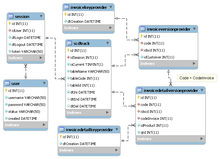Implementations in notable products
The following implementations provide temporal features in a relational database management system (RDBMS).
- MariaDB version 10.3.4 added support for SQL:2011 standard as "System-Versioned Tables". [11]
- Oracle Database – Oracle Workspace Manager is a feature of Oracle Database which enables application developers and DBAs to manage current, proposed and historical versions of data in the same database.
- PostgreSQL version 9.2 added native ranged data types that are capable of implementing all of the features of the pgFoundry temporal contributed extension. [12] [13] The PostgreSQL range types are supported by numerous native operators and functions.
- Teradata provides two products. Teradata version 13.10 and Teradata version 14 have temporal features based on TSQL2 [14] built into the database.
- IBM Db2 version 10 added a feature called "time travel query" [2] which is based on the temporal capabilities of the SQL:2011 standard. [1]
- Microsoft SQL Server introduced Temporal Tables as a feature for SQL Server 2016. The feature is described in a video on Microsoft's "Channel 9" web site. [15]
Non-relational, NoSQL database management systems that provide temporal features including the following:
- TerminusDB is a fully featured open source graph database that natively supports version control, time-travel queries and diffing functions. It has an immutable layer architecture based on delta encoding and succinct data structures. [16]
- MarkLogic introduced bitemporal data support in version 8.0. Time stamps for Valid and System time are stored in JSON or XML documents. [17]
- SirixDB stores snapshots of (currently) XML- and JSON-documents very efficiently in a binary format due to a novel versioning algorithm called sliding snapshot, which balances read-/write-performance and never creates write peaks. Time-travel queries are supported natively as well as diffing functions.
- XTDB (formerly Crux) provides point-in-time bitemporal Datalog queries over transactions and documents ingested from semi-immutable Kafka logs. Documents are automatically indexed to create Entity–attribute–value model indexes without any requirement to define a schema. Transaction operations specify the effective Valid times. Transaction times are assigned by Kafka and enable horizontal scalability via consistent reads.
- RecallGraph is a point-in-time, unitemporal (transaction time) graph database, built on top of ArangoDB. It runs on ArangoDB's Foxx Microservice sub-system. It features VCS-like semantics in many parts of its interface, and is backed by a transactional event tracker. Bitemporality is listed as one of the items in its development roadmap.
- Datomic "is a distributed database that provides ACID transactions, flexible schema, [...] Datalog queries, complete data history, and SQL analytics support." For every change made to the data, it records the responsible transaction and the point in time when it happened. [18]
Temporal databases were one of the earliest forms of data version control, and influenced the development of modern data versioning systems. [19]
Alternatives

Slowly changing dimensions can be used to model temporal relations.

